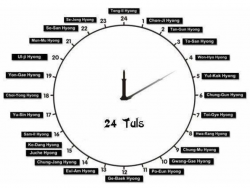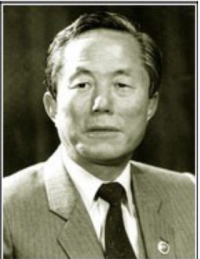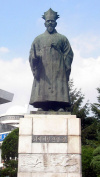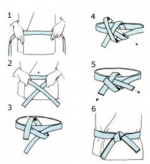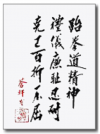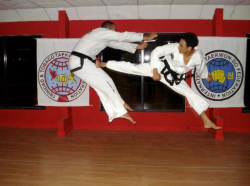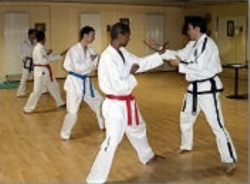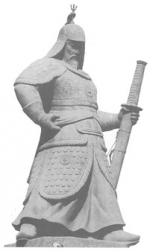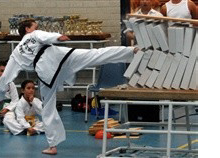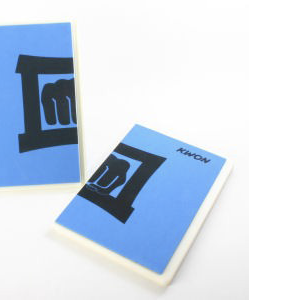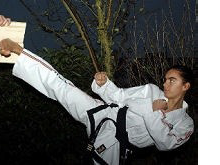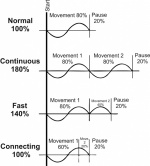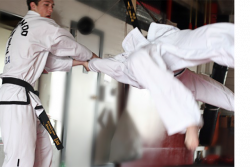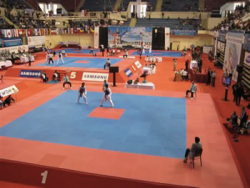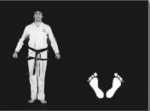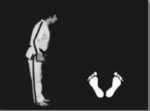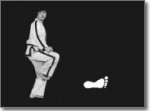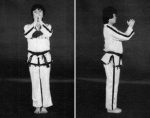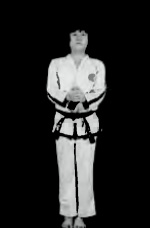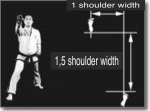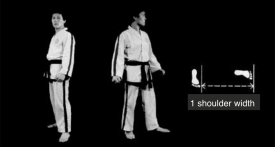Booklet
Student booklet
Select the level of the exam or the full booklet in the following box to have the theory you require :
Basic Knowledge
THIS MUST BE ALWAYS KNOWN, EVEN BEFORE THE FIRST EXAM FOR THE 9th KUP !!!
Korean is read from top to bottom. Taekwondo in Korean consists of 3 characters.
The top is "TAE", the middle is "KWON" and the bottom is the "DO".
Click on the image to enlarge.
What is Taekwondo?
- TAE: Stands for all foot and leg techniques both in attack and in defense
- KWON: Stands for all hand and fist techniques both in attack and in defense
- DO: Literally means the "way", the "art". It is accompanied by a certain mental attitude namely: courtesy, integrity, indomitable spirit, perseverance and self-control.
Behaviour in the Dojang (CLUB)
Wearing watches, rings, earrings, and etc. is prohibited to avoid injuries.
On entering and leaving the dojang: greetings are mandatory. Greeting is expressed by bowing.
In the dojang, discipline must be followed. The Instructor does not leave the dojang during class unless exceptional circumstances appear.
The Tortoise
The turtle is the symbol of Taekwondo. A turtle symbolizes longevity (because she is old), so as the long life of Tae-kwon-do.
She has a hard shell and, therefore, she is protective and comprehensive. All the colors of the belts are built in it.
Click on the image to enlarge
Why do we greet ?
We salute to show our respect when entering and leaving the dojang and a new training partner.
In competition you also greet at first entering the ring in the beginning or abandoning it in the end.
We never turn our back to higher belts on competition, internships, classes, etc.
Exception : While we correct our dobok, we always turn back.
If we give a hand to someone (training, exam, etc.) we put our left hand under our right hand (knuckles under elbow) out of respect and to show that our both hands are weapon-free.
24 Patterns (TULS)
There are 24 patterns (tuls) because the life of a man, perhaps a hundred years,
can be compared with one day (which counts 24 hours) relativing to the eternity. Click on the image to enlarge
Founder Gen. Choi Hong Hi writes: "The pattern represents 24 hours. One day, or all my life. "
Taekwon-Do has 3200 different techniques.
Back to top of page - Back to Welcome Page
Historical background (TAEKWONDO YOKSA) for 9th KUP exam
Taekwondo is no ordinary sport, such as football or tennis. It is a martial art. Therefore, there are certain traditions and customs of the ancient Asia (in our case Korea) attached to it, therefore, Taekwondo has a certain philosophy behind it. To better understand for what tae-kwon-do actually stands for, here are some important notes about the origins, history, philosophy and principles of this Korean defense art. In the East, more than one martial art exist, they were originally practiced by monks, farmers, etc., they usually had to defend themselves against attackers with bare hands and feet without weapons. Korea was no exception. One of the Korean "martial arts" was Taek Kyon. From 1909 to 1945, Korea was occupied by Japan. The rulers triedto force Koreans to practice their own martial arts (ex. Judo, karate, etc.), for example, by prohibiting the Korean arts. Even though it was prohibited, Koreans practiced their own arts in secret to maintain the tradition for future generations.
In 1938, Choi Hong Hi (the person who in 1955 will found modern Taekwondo) departed to Japan to study. In two years, he earned a black belt in karate. On his return to Korea, he devoted himself to the liberation of his country, and he was arrested and ended up in a Japanese prison. In 1945, Korea was liberated. Choi became a lieutenant in the Korean army. Increasingly, he realized that Korea had to get back their own martial art. Choi Hong Hi began developing new techniques and late 1954, the foundation for a new Korean martial art was laid down, which was named Taekwondo on April 11, 1955. The spiritual level of Taekwondo is derived from the traditional Korean ethical and moral values.
Even if taek kyon and karate were sometimes used as a reference at the physical level, the techniques, based on scientific principles (especially the laws from physics), show that Taekwondo is a different martial art (ex. wave motion and the relationship strength-relaxation).
Meanwhile, Choi became General, so he introduced his sport first into the army. In 1966 (April 22), the International Taekwondo Federation (ITF) was established. As a result of the political pressure and the growing frictions between North and South Korea, General left again his homeland in 1972; he settled in Canada.
In South Korea, WTF (World Taekwondo Federation) was founded in response. Both forms of taekwondo have the same base but they have grown so much apart that the differences are greater than the similarities.
With the evolution of time and the changing needs of society, The General made more adjustments. The ITF Taekwondo was not only under the influence of its founder, it is also an evolving sport too. On June 15, 2002 General Choi died. Master Tran Trieu Quan (VIII degree then) was elected president of ITF. The present President of ITF is CHANG UNG.
As a summary :
Taekwondo was founded in 1955 in Korea by General Choi Hong Hi, on April 11; it was the first time the name "Taekwondo" was used. ITF was founded in 1966. Tae-kwon-do has approximately 3,200 techniques
Back to top of page - Back to Welcome Page
Chon-Ji Historical background (TAEKWONDO YOKSA) for 8th KUP exam
"CHON-JI" literally means "heaven and earth". It is interpreted in the East as the creation of the world and the beginning of human history. Therefore this first Tul performed by beginners.
The Tul consists of two parts, the first part for heaven and the second for the earth. It contains 19 moves!
REMEMBER at the end : Bring the left foot back to NARANI SOGI
Back to top of page - Back to Welcome Page
Dan-Gun Historical background (TAEKWONDO YOKSA) for 7th KUP exam
"DAN GUN", is named after the holy Dan Gun, the legendary founder of Korea in the year 2333 BC. This pattern contains 21 movements.
END: Bring the left foot back to narani junbi sogi
Back to top of page - Back to Welcome Page
Do-San Historical background (TAEKWONDO YOKSA) for 6th KUP exam
"DO-SAN" is the pseudonym of the patriot AHN CHANG HO (1876-1938).
The 24 movements represent his entire life which he devoted to furthering the
education of Korea and its independence movement.
END: Bring the right foot back to NARANI JUNBI SOGI
Back to top of page - Back to Welcome Page
Won-Hyo Historical background (TAEKWONDO YOKSA) for 5th KUP exam
"WON-HYO" was the name of the monk who introduced Buddhism to the Silla Dynasty in the year 686 AD.
END: Bring the right foot back to MOA SOGI A
Back to top of page - Back to Welcome Page
Yul-Gok Historical background (TAEKWONDO YOKSA) for 4th KUP exam
"YUL-GOK" is the pseudonym of the great philosopher and scholar YI 1 (1536 - 1584) nicknamed "The Confucius of Korea."
The 38 movements refer to his birthplace on 38° of latitude and the diagram of the Tul means "scholar" = (±)
END: Bring the left foot back to NARANI JUNBI SOGI
Back to top of page - Back to Welcome Page
Joong-Gun Historical background (TAEKWONDO YOKSA) for 3rd KUP exam
"JOONG-GUN" is named in reference to the patriot AHN JOONG-GUN who murdered Hiro Bumi Ito (the (the first Japanese governor-general of Korea).
The 32 movements of the Tul represents the age of Ahn when he was executed in Lui-Shung prison (1910).
End: Bring the left foot to MOA SOGI B
Back to top of page - Back to Welcome Page
Toi-Gye Historical background (TAEKWONDO YOKSA) for 2nd KUP exam
TOI-GYE - 퇴계 / 退溪 is the pen name of the noted scholar Yi Hwang (16th century), an authority on neo-Confucianism.
The 37 movements of the pattern refer to his birthplace on 37-degree latitude, the diagram represents "scholar" as in the Yul-Gok Tul.
End: Bring the right foot to MOA SOGI B
Back to top of page - Back to Welcome Page
Hwa-Rang Historical background (TAEKWONDO YOKSA) for 1st KUP exam
"HWA-RANG" was named after the youth group HWA-RANG originated in the Silla Dynasty in the early 7th century.
The 29 movements refer to the 29th Infantry Division, where Taekwon-Do was developed to maturity.
End: Bring the right foot to MOA SOGI C
Back to top of page - Back to Welcome Page
Meaning of the white belt ( TI ) - 10th Kup
White belt signifies innocence, like a beginner who has no prior knowledge of Taekwondo.
To know how to correctly tie up a belt, follow instructions in the image (click on the image to enlarge)
Back to top of page - Back to Welcome Page
Meaning of the yellow belt ( Ti ) - 8th Kup
The yellow belt means the earth from which the plant takes root and sprouts as the Taekwondo foundation is laid.
Back to top of page - Back to Welcome Page
Meaning of the green belt ( TI ) - 6th Kup
Green: The color of the plant that grows and develops, as the skills in Taekwondo increase.
Back to top of page - Back to Welcome Page
Meaning of the blue belt ( TI ) - 4th Kup
Blue belt signifies the heaven towards which the plant matures into a towering tree as knowledge in Taekwondo increases.
Back to top of page - Back to Welcome Page
Meaning of the red belt ( TI ) - 2nd Kup
Red belt signifies danger, cautioning the student to exercise self-control and warn the opponents to stay away.
Back to top of page - Back to Welcome Page
Knowledge of Taekwondo for 9th KUP
Formal Titles
1st to 3rd DAN : BOOSABUM (Assistant Instructor)
4th to 6th DAN : SABUM (International Instructor)
7th-8th DAN : SAHYUN (Master)
9th DAN : SASUNG (Grand-Master)
Back to top of page - Back to Welcome Page
Counting
| Number | Korean | Number | Korean | Number | Korean |
|---|---|---|---|---|---|
| 1 | Hana | 11 | Yul Hana | 21 | Seumool Hana |
| 2 | Dul | 12 | Yul Dul | 22 | Seumool Dul |
| 3 | Set | 13 | Yul Set | 30 | Soreun |
| 4 | Net | 14 | Yul Net | 40 | Maheun |
| 5 | Dasot | 15 | Yul Dasot | 50 | Sheen |
| 6 | Yosot | 16 | Yul Yosot | 60 | Yesoon |
| 7 | Ilgop | 17 | Yul Ilgop | 70 | Ilheun |
| 8 | Yodul | 18 | Yul Yodul | 80 | Yudoon |
| 9 | Ahop | 19 | Yul Ahop | 90 | Aheun |
| 10 | Yul | 20 | SeuMool | 100 | Bak |
Patterns (TUL)
With patterns movements, the taekwondo student set himself an imaginary fight in which both attacking and defensive techniques are used. There are 24 tuls in Taekwondo. The white belt teaches no real Tul, but teaches preparatory movements: SAJU JIRUGI (4 sides attack) and SAJU MAKGI (4 sides defensive).
Tips
- Pattern must start and end at the same place.
- Always correct posture, position, and composition.
- The muscles of the body are completely relaxed after each movement. During the execution of each movement, the student must control the tension..
- Perform Rhythmic movements not run stiff.
- Both the left and right hand versions equally powerful. Perform each movement with a sense of realism.
- Perform each movement with a sense of realism.
Principles/Tenets of Taekwondo (meaning of "do")
- Courtesy
- Integrity
- Perseverance
- Self-control
- Indomitable spirit
Click on the image to enlarge.
Back to top of page - Back to Welcome Page
The oath of Taekwondo (Kwaran soon soo)
- I shall observe the tenets of Taekwondo.
- I shall respect my instructors and seniors.
- I shall never misuse taekwondo.
- I shall be champion of freedom and justice.
- I shall build a more peaceful world.
Back to top of page - Back to Welcome Page
Knowledge of Taekwondo for 8th KUP
The magic number 9:
One starts with 9th kup and ends 9th Dan in Taekwondo because 9 is a magic number for the Asians.
Multiply it by any other number, and the sum of the digits of the result is always 9. Ex.: 9 x 112 = 1008 the sum of digits: 1 + 0 + 0 + 8 = 9.
The number 9 in the East is an important sacred number. Moreover, it is mysterious, because it keeps coming back.
Sparring
A Taekwondo fight on competition will be decided by points and takes two minutes. There are four corner referees who give points and one ring referee on the field provided.
Point allocation
In sparring, the points are allocated as here below :
- 1 point for all fist techniques on the body or face
- 2 points for all leg techniques on the body
- 3 points for all leg techniques on the face
Warnings:
- Ui Ju Hanna: before a warning is given, the fight is stopped (= heachyo) and then a warning is attributed to the accused person. After three warnings, one point is deducted.
- Gam Jum Hanna: you can get a minus point through full contact (too hard, usually uncontrolled), falling down or ignoring umpire commands. Three direct minus points means disqualification (Sil Kyuk).
You get a warning by :
- Pushing
- Kicking below the belt
- Grabbing opponent
- Performing a technique on the back
- Deliberately avoiding battle (running away)
- Falling down (touch by hand on ground)
- Going out of the ring
- Attacking without looking
- turning away
- talking
- Claiming provoking point
Back to top of page - Back to Welcome Page
Matsogi (step sparring)
Taekwondo students learn the techniques of Matsogi. Those are taught with the movements from the tuls to learn how to apply them in sparring.
There are three types of Matsogi: Sambo Matsogi (three step sparring), Ibo Matsogi (two-step sparring) and Il- bo Matsogi (one step sparring).
For the yellow belt exam, candidates must perform five three steps. This is done in pairs.
Methodology
You stand facing each other, bow to each other, then the attacker (pre-arranged) measures the distance needed to perform the attack. After that, the attacker goes backward with his right leg in gunnun sogi najunde bakat palmok makgi. This is the initial position in which each three-step is carried out.
In theory, the defender determines which attack will be performed, but for practical reasons (on the distance between the performers), we recommend that the attacker decides which attack he will be performing. After all, the defender knows beforehand what technique the attacker will use).
Once the attacker has called the technique, he states that he is ready to attack ("TSE"). The defender ponders what technique he will use to defend and indicates that he is ready ("TSE"). The defender may take his time to get prepared for.
Afterwards the attacker kicks or punches and the defender defends/blocks three times. The defender then performs a counterattack.
Then reverse roles. The attacker brings his front leg back to NARANI SOGI (ie backwards) and the defender brings his back leg forward to NARANI SOGI. Now it's up to the person who has just defended for to attack.
Attention to:
It is important to set the feet in the right place. In an attack in niunja sogi, the attacker's feet are placed on the outside of the feet of the defender. If an attack is in gunnun sogi the foot of the attacker is placed on the right side of the foot of the defender, so first on the outside and second time on the inside.
The defender performs a counterattack depending on the distance between the two people. If the distance is large then a kicking technique can be used; it is recommended to have a hand technique at a short distance.
Back to top of page - Back to Welcome Page
Knowledge of Taekwondo for 7th KUP
Korean "Grammar"
Now you already know some definitions in Korean, so we can say exactly what we are performing and what technique we are performing.
We try a translation:
Ex. 1: 1st movement of SAJU JIRUGI: orun gunnun sogi ap jumok kaunde baro ap jirugi - Literal translation: right front stance with forward punch in the middle section with support arm and leg on the same side.
Ex. 2: the last movement of Dan-Gun: wen niunja sogi sonkal kaunde bandae bakuro taerigi - Literal translation: left L-stance with knife hand stroke in the middle section from the inside out.
RULE
There is an order. Using it makes everything clearer.
1. Firstly the side (orun / wen)
2. Secondly the position (gunnun so, niunja so ...)
3. Thirdly the strike or block
4. Fourthly the height of targeting action
(5). Fifthly the baro / bandae (not always used)
6. Sixthly the direction and type of strike/block
Anuro / Bakuro
- ANURO: From the outside to the inside
- BAKURO: From the inside out
- ANURO: From the outside to the inside
Baro / Bandae
Rules in GUNNUN SOGI
- BARO: support arm and leg on the same side
- BANDAE: support arm and leg on the opposite side
Rules in NIUNJA SOGI
- BANDAE: support arm and leg on the same side
- BARO: support arm and leg on the opposite side
Back to top of page - Back to Welcome Page
Knowledge of Taekwondo for 6th KUP
The phases of a movement
In TUL and MATSUGI it is important to finish correctly each executed techniques. Therefore, let's take a closer look.
Ex: we perform ORUN GUNNUN SOGI, NAJUNDE BAKKAT PALMOK MAKGI.
- The first phase is the preparatory phase: we progress forward and we put our defense up. During this phase, we use an
undulating motion to develop speed.
- The second phase is the moment of the impact: this is the moment when the part of the body that performs the defense against the object to be blocked, is hit. At the time of the impact, our body is tensed in order to pass on the power and speed which we have developed through the part of the body, that carries out the blocking, to the object to be blocked.
- The second phase is the moment of the impact: this is the moment when the part of the body that performs the defense against the object to be blocked, is hit. At the time of the impact, our body is tensed in order to pass on the power and speed which we have developed through the part of the body, that carries out the blocking, to the object to be blocked.
In short, we need to move that we developed in the first phase to the end.
It is important that the motion of the legs, the arm movements and respiration are simultaneous. It is only in this case possible to carry out a powerful technique.
- The final phase is the phase of the relaxation of the muscles because the defense is already completed. It is only when the muscles are relaxed that we can perform the next move.
Back to top of page - Back to Welcome Page
THE DYNASTIES
Current North and South Korea earlier consisted of three dynasties: the Koguryo, Baekje and Silla Dynasty.:
- Koguryo (37 B.C. to 668 A.D.)
- Paekje (18 to 600 B.C. A.D.)
- Silla (57 to 935 B.C. A.D.)
Silla unified the kingdoms together by winning the war against Paekje in 660 AD and Koguryo in 668 AD. What followed was a time of peace and HwaRang grew from a military organization to a group specialized in poetry and music.
In 936 AD when Wang Kon founded the Koryo dynasty (an abbreviation of Koguryo). The Korean name KoryoIn derives from the Silla Dynasty, the principles of Taekwondo began with the youth group Hwarang DO. At that time the martial art that this group performed was called Taekyon or SOO BIN GI because the name "Taekwon-do ' only came into place in 1955.
Modern Taekwondo is a combination of many other martial arts. The most important of these is the Japanese Karate. This is because Japan occupied Korea from 1910 to the end of the World War II. During this war, lots of Korean soldiers were trained in Japan. During this occupation Japan tried to erase all traces of the Korean culture, including eliminating the traditional martial arts. The influence that Karate has on Taekwondo enriched the quick linear movements also used in Taekwondo.
After World War II, when Korea became independent, several kwans arose. These were:
- Chung Do Kwan
- Moo Duk Kwan
- Yun Moo Kwan
- Chang Moo Kwan
- Oh Do Kwan
- Ji Do Kwan
- Chi Do Kwan
- Song Moo Kwan
The Kwan united in 1955 as Tae Soo Do. In the beginning of 1957, the name Taekwondo was set equal to the name Tae Kyon by several Korean martial arts masters.
General Choi Hong-Hi required the army to train Taekwondo. Thus the first Korean soldiers were Taekwondo students. The police and air force had to learn Taekwondo. At that time Taekwondo was merely a Korean version of Shotokan Karate.
Back to top of page - Back to Welcome Page
Knowledge of Taekwondo for 5th KUP
Matsogi
Reminder
Taekwondo students learn the techniques of Matsogi. Those are taught with the movements from the tuls to learn how to apply them in sparring.
There are three types of Matsogi: Sambo Matsogi (three step sparring), Ibo Matsogi (two-step sparring) and Il- bo Matsogi (one step sparring).
For the yellow belt exam, candidates must perform five three steps. This is done in pairs.
Methodology
You stand facing each other, bow to each other, then the attacker (pre-arranged) measures the distance needed to perform the attack. After that, the attacker goes backward with his right leg in gunnun sogi najunde bakat palmok makgi. This is the initial position in which each three-step is carried out.
In theory, the defender determines which attack will be performed, but for practical reasons (on the distance between the performers), we recommend that the attacker decides which attack he will be performing. After all, the defender knows beforehand what technique the attacker will use).
Once the attacker has called the technique, he states that he is ready to attack ("TSE"). The defender ponders what technique he will use to defend and indicates that he is ready ("TSE"). The defender may take his time to get prepared for.
Afterwards the attacker kicks or punches and the defender defends/blocks three times. The defender then performs a counterattack.
Then reverse roles. The attacker brings his front leg back to NARANI SOGI (ie backwards) and the defender brings his back leg forward to NARANI SOGI. Now it's up to the person who has just defended for to attack.
Attention to:
It is important to set the feet in the right place. In an attack in niunja sogi, the attacker's feet are placed on the outside of the feet of the defender. If an attack is in gunnun sogi the foot of the attacker is placed on the right side of the foot of the defender, so first on the outside and second time on the inside.
The defender performs a counterattack depending on the distance between the two people. If the distance is large then a kicking technique can be used; it is recommended to have a hand technique at a short distance.
Back to top of page - Back to Welcome Page
For the exam
The student must perform 12 SAMBO MATSOGI program. In addition, the student must be able perform 5 IBO MATSOGI (two step sparring).
The difference with the three-step consists in the method of attack: in contrast to the three step sparring, where the attacker attacked three times with the same attack, the attack is two-step sparring consists off two different attacks; one kick and one punch, or vice versa.
Similarly, the starting position, in which the attacker starts, is different from the SAMBO MATSOGI.
Instead of a GUNNUN SOGI NAJUNDE BAKKAT PALMOK MAKGI, the attacker begins in NIUNJA SOGI PALMOK DAEBI MAKGI.
Back to top of page - Back to Welcome Page
BREAK TECHNIQUES OR KYEK PA
Many think that they need a big shape and size needed to break a board. But that is not so. There are different things to look at. Here are the factors which lead to a higher degree of physical strength.
- Action-Reaction : Every force has an equal and opposite force. Therefore, in taekwondo with every move you make, the hand is quickly withdrawn to the hip.
- Concentration: The maximum power is only given at the time of impact.
- Balance: The body is balanced with each technique. This can be done by taking a proper position to take.
- Breathing: The control of breathing not only affects the speed and power. It can also prepare the body for a fight. Never breathe at the moment of the impact!
- Wave motion: Relationship strength - relaxation.
- Speed: Speed is the most essential factor when invoking force or pressure.
Scientifically, force equals mass times acceleration
Force = mass x speed
To know :
The bursting test must be passed with 1.5 to 3.5 cm wide pine 30x30 cm plank of wood.
How to proceed?
- Come to the place, then greet.
- Measure the distance down to the shelf. Take a good distance, certainly not too short.
- Breathe in and out. Measure one more time the distance.
- Come in JUNBI.
- Break the shelf.
- Come back in JUNBI.
- Greet.
Note: Always be peaceful and calm. Remember, use your whole body. You break the board with your hips and shoulders. Get it off your power. Also remember; you won’t try to break it; you will break it.
Back to top of page - Back to Welcome Page
Knowledge of Taekwondo for 4th KUP
Sine Wave
What makes Taekwon-do unique is the sine wave motion to generate maximum power according to the theory of force.
It is used in almost every movement. Natural wave motion is simple.
During lessons and seminars Taekwon-Do practitioners learn to apply the "sine wave" in their techniques.
What we do in fact, in the execution of the wave motion in Taekwondo techniques, is moving the center of mass of the body. That means that if we were to draw the outlining of the hip motion, it would look like a sine wave (click on figures to enlarge).
There are some advantages to use a wave movement that are related to the training of secrets of taekwon-do. To move the center of our mass in the movement of a wave, our legs must be bent while the body is in motion. To keep the legs and arms bent over a movement, we need to be relaxed. By relaxing the body, extra speed is given to a technique because the various parts of the body do not work against each other, as that is the case with voltage. Force equals mass times velocity squared, so a small gain in speed and a big gain in strength.
When we perform a wave motion, we also need to make use of a "knee suspension" (knee spring) on the correct manner. By bending our knees as we move, the body is moved up and down forward by the knee bend. While the body moves, our center of mass moves on a curve, which is a form of acceleration.
Finally, when wave motion is applied, it contributes to the use of gravity to our advantage and can assure that the acceleration increases at the moment of impact.
To apply the wave correctly in Taekwon-Do, we need to adjust the shape of the wave to achieve maximum power. In other words, the sine wave is not a uniform curve as shown in Figure 1. The wave motion is adapted so that the body "falls" at the time that it has reached the half of the trajectory of a technique and comes up to maximum height at about three quarters of the route. Then, the body comes down quickly at the end of the movement. The rapid "fall" at the end of the technique helps our mass to accelerate into the target, using the force of gravity.
Back to top of page - Back to Welcome Page
Five different tempos
The base of the wave motion is down-up-down, this means there is always a downward movement, followed by an upward movement and ending with a downward movement. However, there are variations to the wave motion which are dependent on the rate of the movement and the combination of the used techniques. There are five different tempos :
- Normal motion
- In SAJU JIRUGI, SAJU MAKGI AND CHON-JI TUL, Taekwondo students learn the normal pace of connected movements. That is the first "motion": normal motion (normal speed). Movements performed in a normal pace, with a wave motion in one breath.
- Continuous motion
- DAN-GUN teaches Taekwondo students the second motion: continuous motion (sequential pace). Two movements are performed sequentially, twice with wave motion in a single breath.
- Fast motion
- Do-San brings in a new motion : fast motion (fast pace). Two motions are carried out in quick succession, twice with wave motion in two breaths.
- Connecting motion
- Normal motion
In YUL-GOK brings a new motion: connecting motion (attached pace). Two movements performed connected, with one wave motion in one breath.
- Slow motion
- JOONG-GUN completes the fifth and final motion: slow motion (slow pace). In slow motion, the move is slow but, in relation to the theory of power there is acceleration at the end of the movement. There is one (slow) movement, one wave at a (delayed) breathing. Slow motion performances of techniques allow more body control and exercises the balance of the student.
- Slow motion
Determine the five different tempos of the wave motion, of which three variants are:
- Full wave
- 2/3 wave
- 1/3 wave
There is a full wave motion (down-up-down) ONLY in normal motion, continuous motion and slow motion.
In fast motion, there is a 2/3 wave motion, since there is only an up and a downward motion in the movement. An example can be found in DO-SAN TUL: the two punches that follow the AHPCHA-BUSUGI (movements 15 & 16 and 19 & 20)
In the connecting motion, there is a 1/3 wave motion, since there is only a downward movement taking place. An example can be found in YUL-GOK TUL: the impact that follows the second hooking block (movements 16 & 17 and 19 & 20).
Back to top of page - Back to Welcome Page
Knowledge of Taekwondo for 3rd KUP
Matsogi
For the exam, the student must perform 10 SAMBO MATSOGI programs. In addition, the student's needs 10 IBO MATSOGI (two-step) demonstration. During the exam, the student will also perform 8-ILBO MATSOGI's (one step sparing).
Should you need a reminder on how to proceed, see this link.
Hosinsul
Foreword
In HOSINSUL (self-defense), there usually is a physical contact between the attacker to defender.
In defense against weapons there usually is a physical contact of the defender against the attacker.
We divide hosinsul into two parts:
- Physical contact attacker
- Forward with weapons
Therefore, ITF Taekwondo is a modern sport considering all possible defense techniques such as long distance (legs), medium range (arms, elbow, knee) or close combat (throwing, extrication, vital points).
Note: It is always possible that one is faced with a very strong opponent. Here are two solutions:
- Use your speed and a rotational movement.
- Hit the opponent on a painful place.
Physical contact attacker
The opponent holds.
Three possibilities:
- Offensive movement: attacks with stroke or stamp on a vital place or vulnerable body spot.
- Breaking movement: on the attacking limb.
- Liberation movement: a twisting motion followed by counterattack.
Attack Situations
- standing
- kneeling
- lying
- sudden attack of opponent
Back to top of page - Back to Welcome Page
Throwing and falling techniques
Falling is an art, take into account these rules :
- Relax Body
- Try to fall on your side, not your front or back.
- Safely absorb the shock with the palm of the hand on the ground.
- avoid hitting the head.
- Legs high.
Don’t just throw your opponent to the ground during training, you do not want to hurt him.
Ground Principle: make opponent off balance. Possibilities:
- Standing
- Kneeling
- Lying
Attacker with weapons
You are attacked with a weapon (s). Dodging is the most appropriate move, but you're not safe enough.
Try to let the opponent make an additional "step". To be so close to him (or to the weapon according to your placement) makes it easier to finish your counterattack.
Pihagi (= evade, avoid) is important. Left or right, but not back in line. Block against the arm or hand, but not against the weapon (don’t touch the weapon when blocking, especially when blocking knives).
Back to top of page - Back to Welcome Page
Knowledge of Taekwondo for 2nd KUP
Refereeing at competitions
Once you’re a yellow belt, you learn something about the rules. Now we will proceed in how arbitration works on competitions..
Referees are both women and men. This is how it is going.
Sparring
How and what?
A fight usually lasts 2 minutes and is decided by points. If there is a tie after the 2 minutes, another 1 minute of fighting is foreseen. If after that minute there still is no winner, then there will be a golden point.
Golden point sparring is when the two fighters have 1 minute to be the first to make a point. All techniques will give 1 point, even leg techniques to the head. The first one scoring a point according to the referees wins the fight.
Who?
Participants are divided into: chong (blue) and hong (red).
Corner referees: scoring the points. You score a point when one or more (corner referee) saw it.
Center Referee: leading the fight. He starts and stops the fight. He is the person who (center referee) interrupts the fight for giving warnings.
The jury table: The table has a Jury President and is responsible for the ring. He keeps track of which participants have to come after the current contestants. Also, there is a jury member who maintains the warnings for the final decision. The Timekeeper watches the time during the fight. There is one center referee present at the table as a reserve.
Terug naar top van deze pagina - Terug naar de welkom pagina
Points
Items are listed on the points form by the corner referees. After the fight the central umpire receives the corner referees’ forms. Afterwards he brings the forms to the table. Since everything is already counted, the result is communicated by the jury president who names the winner
In sparring, the points are allocated as here below :
- 1 point for all fist techniques on the body or face
- 2 points for all leg techniques on the body
- 3 points for all leg techniques on the face
Warnings:
- Ui Ju Hanna: before a warning is given, the fight is stopped (= heachyo) and then a warning is attributed to the accused person. After three warnings, one point is deducted.
- Gam Jum Hanna: you can get a minus point through full contact (too hard, usually uncontrolled), falling down or ignoring umpire commands. Three direct minus points means disqualification (Sil Kyuk).
You get a warning by :
- Pushing
- Kicking below the belt
- Grabbing opponent
- Performing a technique on the back
- Deliberately avoiding battle (running away)
- Falling down (touch by hand on ground)
- Going out of the ring
- Attacking without looking
- turning away
- talking
- Claiming provoking point
Back to top of page - Back to Welcome Page
Tuls
How and what?
The higher the grade, the more a person has to perform tuls on competition. Colored belts usually performed only one tul.
Who?
There are five judges who assess the Tuls. There is still the table with the referee.
Points
The jury always takes several factors into account, including :
- strength
- balance
- breathing
- technique
- rhythm.
There are two systems used in Tul, namely points or waste system.
The five referees have the duty to designate a winner or a tie. The majority of these five is the winner.
- Example 2 votes for hong and 3 for chong, chong = win.
In the point system, each referee scores points separately.
Separate points are given according to different factors. Maximum 5 points for technique and maximum 3 for strength, balance, breathing or rhythm each. One gets a final score with a maximum value of 17.
Back to top of page - Back to Welcome Page
Team sparring
In team sparring, there are five people per team. There is a toss, the winner decides which team chooses the person to bring forward as first. Points are given as described here below :
- 1 point for a tie
- 2 points for a win
The team with the most points wins.
Team Tul
The same rules as in tul are applied here. It can be assessed using waste system or the points system
A team consists of 3 to 5 people. When the points are returned separately, points are given according to the different factors as in Tul.
There is one additional factor, a maximum of 5 points for presentation, teamwork and choreography. So, a maximum value of 22 points.
Back to top of page - Back to Welcome Page
Special technics
In this discipline, the contestants have to give a kicking technique as high or as far as possible. This is depending on each discipline. A few examples :
- Tymio nopi ap cha busigi
- Tymio nomo yop cha jirugi
- Tymio dollyo chagi
- ...
It is usually a knockout round. IT goes further or higher until there is a winner. On the big competitions, points are used and there, the contestants have to perform various steps before giving the kicking technique.
Power breaking
Here we try to break, with a hand or foot technique, as many boards as possible that are disposed. Also, there can be a waste or points system used. Some techniques :
- Ap jumok jirugi
- Yop cha jirugi
- Bandae dollyo chagi
- ...
Traditional sparring
Here, a style battle is performed by a pair. It only has a few limits and is fully rehearsed by the pair. The referees determine the two winners on several factors. The different duos come taking turns on the ring.
Back to top of page - Back to Welcome Page
THE ULTIMATE TIPS FOR A GOOD TUL
Tul must begin and end on the same spot.
Always have a correct posture, stance and position.
The muscles of the body are completely relaxed after each operation and totally strained during movement.
Rhythmic movement execution and no stiff walking.
All in one coordinated action.
Fast or slow implementation depending on the imposed exercise.
Each tul must be perfectly known before one learns the next.
Know the significance of every move.
Perform each movement with a sense of realism.
Both offensive and defensive techniques, left- and right-hand techniques must as powerful and streamlined as the other.
Each tul is equivalent.
Back to top of page - Back to Welcome Page
Knowledge of Taekwondo for 1st KUP
Taekwon-Do is a Sport
To develop ITF Taekwondo as a sport and encourage greater participation in competitions, major changes will be made to tournament rules, to the competition calendar, and to the qualification process.
Training for umpires will be upgraded, and we will investigate the use of a computerized scoring system. Competitors will be happier and motivated to continue when our competitions are safer and scoring is more precise and reliable. Competitions held in well-known locations around the globe will focus attention on the ITF and will
result in greater visibility.
Taekwon-Do is a Martial Art
To improve ITF Taekwon-Do as a martial art, there will be increased emphasis on the traditional core values and protocol. The teaching of self-defense our "raison d'être" will be improved. We will use seminars, documentation,videos, and other means of communication to spread knowledge of ITF Taekwon-Do, reaching out to new markets and to new participants, particularly women.
Taekwon-Do is a Way of Life
To demonstrate the value of ITF Taekwon-Do as a way of life, we must teach all facets of ITF Taekwon-Do, including the Do. I can tell you that General Choi’s true last wishes and words of guidance for us and for the future are found in the introduction of his last book Moral Culture. The General had come to realize that most of the emphasis had been placed on the teaching of the technical aspects of ITF Taekwon-Do. He felt it would be up to the next generation to give equal importance to the teaching of the Do.
We have already started working on a Code of Ethics based on the Do. In future, we will use all the resources available to us to teach the whole ITF Taekwon-Do: the technical and the Do. By studying the Do, our students will grow in understanding of the “why”, not only the “how”.
The ultimate purpose of life is the search for happiness. Many people suffer because they do not have the proper value system that leads to a balanced life and happiness. We have a solid philosophy and the tools to apply it in our lives. Now we must put in place a structure to teach the mental and spiritual aspects of ITF Taekwon-Do to our students so that they will be able to achieve a balanced life and happiness.
We have been teaching ITF Taekwon-Do as a way of life for some years and we believe we can help people to find a balance between family life, school or work, and ITF Taekwon-Do. Teaching this approach will open many doors to us.
Taekwon-Do can be a Tool for Social Development. To use ITF Taekwon-Do as a tool for social development, we must practice Taekwon-Do not just for ourselves, but also to improve life in our communities. ITF Taekwon-Do can be a powerful tool to help solve social problems such as drug abuse and juvenile delinquency, providing structure, discipline, and self-confidence that carry over into all aspects of life.
We hear a lot about efforts to reduce poverty in the world. By educating people with ITF Taekwon-Do values and practices, and by showing them that there is hope of improving their quality of life, we will be making an important contribution.
The ITF can develop programs such as intensive instructor training for the unemployed and ITF Taekwon-Do courses offered at affordable prices. Starting with small-scale projects, our success will attract the attention and support of international development agencies and governments around the world. In Canada we have had excellent results with this type of program, and we will assist you to implant pilot projects in your countries.
There is a lot of work to be done in this area, but there is also an enormous potential for improvement.
By striving to develop all four facets of Taekwon-do to the maximum, we can realize our full potential as individuals and as an organization. Working together, we can do great things!
Back to top of page - Back to Welcome Page
Vocabulary for 9th KUP
| Korean | English |
|---|---|
| CHARYOT | Attention |
| KYONG YE | Greet |
| SOGI | Stance |
| JIRUGI | Punch |
| CHAGI | Kick |
| MAKGI | Block |
| JUMBI | Get ready |
| SIJAK | Start |
| KUMAN | Stop |
| HAECHYO | Cease |
| SWIYO | Relax |
| DOJANG | Training place |
| WEN | Left |
| ORUN | Right |
| NAJUNDE | High |
| KAUNDE | Middle |
| NOPUNDE | Low |
| NAERYO | Downward |
| OLLIGI | Upward |
| AP | Forward |
| DWIT | Backward |
| YOP | Sideways |
| BANDAE | REVERSE |
| PALMOK | FOREARM |
| JOOMUK | FIST |
| SONKAL | Knife-hand |
| HAESAN | End of training |
Back to top of page - Back to Welcome Page
Vocabulary for 8th KUP
| Korean | English |
|---|---|
| DWIRO OMGYO DIDIMYO DOLGI | Backward step turn (rotation Chon-Ji) |
| MIKULGI | Sliding on long distance |
| JAJUN BAL | Sliding on short distance - foot shifting |
Back to top of page - Back to Welcome Page
Vocabulary for 7th KUP
| Korean | English |
|---|---|
| BARO JIRUGI | Punch (foot and hand of the same side) |
| BANDAE JIRUGI | Punch (foot and hand of opposite side) |
| ANURO | Open body - from outside to inside |
| BAKURO | Closed body - from inside to outside |
Back to top of page - Back to Welcome Page
Hand-Technique for 9th KUP
| Korean | English |
|---|---|
| AP JOOMUK BARO JIRUGI | Front forefist middle obverse punch |
| NAJUNDE BAKAT PALMOK BARO MAKGI | Low outer forearm obverse block |
| NADJUNDE SONKAL MAKGI | Low knife-hand block |
| AN PALMOK YOP MAKGI | Inside forearm block |
Back to top of page - Back to Welcome Page
Hand-Technique for 8th KUP
| Korean | English |
|---|---|
| AN PALMOK BANDAE MAKGI | Forearm middle reverse block (Bandae because of the Niunja Sogi stance) |
Back to top of page - Back to Welcome Page
Hand-Technique for 7th KUP
| Korean | English |
|---|---|
| SONKAL DAEBI MAKGI | Knife-hand protective double block |
| PALMOK DAEBI MAKG | Forearm protective double block |
| NOPUNDE AP JOOMUK JIRUGI | High forward fist punch |
| SANG PALMOK MAKGI | Twin forearm high block (9th movement of Dan-Dun) |
| BAKKAT PALMOK CHOOKYO MAKGI | Outer forearm rising block (14th movement of Dan-Gun) |
| KAUNDE SONKAL YOP TAERIGI | Middle knife-hand side strike (18th movement of Dan-Gun) |
Back to top of page - Back to Welcome Page
Hand-Technique for 6th KUP
| Korean | English |
|---|---|
| NOPUNDE BAKAT PALMOK MAKGI | High outer forearm block |
| SUN SONKUT BARO TULGI | Straight fingertip thrust |
| JAEP SYUL TAE | Release from grab |
| DUNG JOOMUK NOPUNDE YOP TAERIGI | Back fist high obverse side strike |
| AP JOOMUK BANDAE JIRUGI | Front forefist middle reverse punch |
| BAKAT PALMOK NOPUNDE HECHYO MAKGI | Outer forearm high wedging block |
Back to top of page - Back to Welcome Page
Hand-Technique for 5th KUP
| Korean | English |
|---|---|
| NOPUNDE SONKAL ANURO TAERIGI | High knife-hand inward strike |
| AN PALMOK DOLLIMYO MAKGI | Forearm circular block |
Back to top of page - Back to Welcome Page
Hand-Technique for 4th KUP
| Korean | English |
|---|---|
| SONDABAK GOLCHO MAKGI | Arc hand middle obverse hooking block |
| AP PALKUP TAERIGI | Front elbow strike |
| SANG SONKAL MAKGI | Twin knife-hand block |
| DUNG JOOMUK YOP TAERIGI | Back fist high side strike |
Back to top of page - Back to Welcome Page
Hand-Technique for 3rd KUP
| Korean | English |
|---|---|
| SONKAL DUNG KAUNDE BAKURO MAKGI | Reverse knife-hand middle reverse block |
| SONDABAK BANDAE OLLYO MAKGI | Palm upward block |
| WI PALKUP TAERIGI | Upper elbow strike |
| SANG JOOMUK NOPUNDE SEWO JIRUGI | Twin fist high vertical punch |
| SANG JOOMUK DWIJIBO JIRUGI | Twin fist upset punch |
| KYOCHA JOOMUK CHOOKYO MAKGI | X-fist rising block |
| DOO PALMOK NOPUNDE MAKGI | Double forearm block |
| SONDABAK BANDAE NOOLLO MAKGI | Palm pressing block |
| KYOCHA JIRUGI | Front forefist angle punch |
| DIGUTJA MAKGI | U-shape block |
Back to top of page - Back to Welcome Page
Hand-Technique for 2nd KUP
| Korean | English |
|---|---|
| DWIJIBUM SONKUT NAJUNDE BANDAE TULGI | Upset fingertip thrust |
| DUNG JOOMUK YOPDWI TAERIGI | Back fist side back block |
| KYOCHA JOOMUK NOOLLO MAKGI | X-fist pressing block |
| SANG PALKUP YOP TUYLGI | Twin side elbow thrust |
| BAKKAT PALMOK SANG MAKGI | Outer forearm w-shape block |
| DOO PALMOK NAJUNDE MIRO MAKGI | Double forearm low pushing block |
| SANG AP JAPKEE | Grab the head |
Back to top of page - Back to Welcome Page
Hand-Technique for 1st KUP
| Korean | English |
|---|---|
| SONDABAK MIRO MAKGI | Palm pushing block |
| AP JOOMUK OLLYO JIRUGI | Front forefist upward punch |
| SONKAL NAERYO TAERIGI | Knife-hand downward strike |
| YOP PALKUP TULGI | Side elbow thrust |
| YOPAP MAKGI | Inner forearm high side front block |
Back to top of page - Back to Welcome Page
Hand-Technique for 1st DAN
| Korean | English |
|---|---|
| SONKAL NOPUNDE BARO AP TAERIGI | High knife-hand obverse front strike |
| SONKAL DUNG NOPUNDE AP TAERIGI | Reverse knife-hand reverse high front strike |
| KYOCHA SONKAL KAUNDE MOMCHO MAKGI | X-knife-hand checking block |
| DOO SONDABAK OLLYO MAKGI | Twin-palm upward block |
Back to top of page - Back to Welcome Page
Foot-Technique for 6th KUP
| Korean | English |
|---|---|
| APCHA BUSIGI | Front snap kick |
Back to top of page - Back to Welcome Page
Foot-Technique for 5th KUP
| Korean | English |
|---|---|
| YOP CHAGI | Side piercing kick |
| YOPCHA JIRUGI | Side piercing kick and punch together |
Back to top of page - Back to Welcome Page
Foot-Technique for 2nd KUP
| Korean | English |
|---|---|
| MOORUP OLLYO CHAGI | Knee upward kick |
Back to top of page - Back to Welcome Page
Foot-Technique for 1st KUP
| Korean | English |
|---|---|
| DOLLYO CHAGI | Turning kick |
Back to top of page - Back to Welcome Page
Foot-Technique for 1st DAN
| Korean | English |
|---|---|
| TWIMYO YOP CHAGI | Flying side piercing kick |
| DWIT CHAGI | Back piercing kick |
Back to top of page - Back to Welcome Page
CHARYOT SOGI - Attention stance
This is the position used for attention, before and after exercise.
1. Feet form an angle of 45 degrees.
2. Drop fists down naturally. The elbows are slightly curved/bended.
3. The fists are clenched slightly.
4. The eyes look forward, just above the horizontal line.
Back to top of page - Back to Welcome Page
GUNNUN SOGI - Walking stance
This is a strong position, both front and rear feet are offensive and defensive.
Move one of feet forwards or backwards. The length between both feet should be the length of the shoulders.
A stand with a length longer than a one and a half shoulder width makes the movement slow and one is vulnerable to attack from the side, front or back.
Bend the front leg so that the heel in a straight aligns with the knee. The rear leg has to be completely stretched.
Distribute your body weight equally on both feet. Make sure the toes of the front foot pointing forward.
The toes of the back-foot must be pointed 25 degrees outwards When this is more than 25 degrees, the rear leg is more vulnerable to an attack from behind.
Tighten the muscles of both feet with the sense to bring them together.
Tighten the muscles of both feet with the sense to bring them together.
Back to top of page - Back to Welcome Page
JUNBI SOGI - Ready stance
Tae-kwon-do has many modes, which emerge in the patterns. The ready stance is not part of an action, but it is a position from which the student starts his pattern. This position is ideal for increasing the concentration.
Back to top of page - Back to Welcome Page
KYONG YE JASE - Greeting stance
This is the attitude and the movement that one must make when greeting the teacher, a fellow student, the jury and an opponent during competitions :
Bend the body 15 degrees forward.
Keep looking into the opponent's eyes.
Back to top of page - Back to Welcome Page
NARANI SOGI - Parallel stance
Spread the feet parallel to the shoulders' width.
The toes need to be pointing forwards.
Fists are 5 cm away from each other and on the height of the belt and 7 cm away from the body.
Back to top of page - Back to Welcome Page
NIUNJA SOGI - L-Stance
This position is widely used in the defense, but for the offensive stand also useful. The front foot is in place to give a kick.
It only needs a small displacement of body weight to Make a niunja sogi. Move one foot forward or backwards, so that the length between both feet is slightly less than about a shoulder width
There is pretty much a straight-line corner formed. It is recommended to move both feet to about 15 degrees to point inside, this gives better stability.
Bend the back leg until the knee is in a straight vertical line with the toes, ditto the front leg. Make sure that the hip stays in line with the inner knee joint. The body weight distribution is 70 percent on the back leg and 30 percent on the front leg.
ANNUN SOGI - Sitting stance
This is a very stable position for a lateral movement. This mode is also widely used for impact/punching exercises and for the leg muscles development.
One of the major advantages of this mode is that you can shift into walking stance without relocating the feet.
Spread one of the two legs to the side at a distance of one and a half shoulder width between the two toes.
Make sure the toes are pointing forward and the body weight is equally distributed on both legs.
Bending the knees outward, bending until the knee is over the ball of the foot
Tighten the thigh muscles and increase the strength of the legs by pulling the soles of the feet on the sides. Finishing a movement over the ground, push the chest and abdomen forward and push the hips backwards while the belly (muscle) is tightened.
Do not make the stance too wide. If you do, your speed and agility will dramatically decrease
stance may executable with a full face or side facing, both in attack and in defense.
The stance makes it possible to execute movements going straight forward or sideways, both in attack and in defense.
Back to top of page - Back to Welcome Page
GOJUNG SOGI - Fixed Stance
This is an effective mode to work out for an attack or go to the side. This position is equal to the short mode (niunja sogi) with the following exceptions:
- Body weight is evenly distributed on both legs.
- The distance between both feet is one and a half shoulder width.
When the right leg is forward, we call the position a right fixed stance and when the left leg is forward we call it a left fixed position.
The stand is always performed in a side facing.
Back to top of page - Back to Welcome Page
GUBURYO SOGI - Bending Stance
This position serves as a preparatory position for backward and lateral steps, generally defensive movements.
While standing on the right leg, there is a right flexed position, vice versa.
You can execute the position in full facing or side facing.
Back to top of page - Back to Welcome Page
MOA SOGI A - Closed Stance
A starting position in which with the feet are against each other. Possible executable with full face or a side facing.
Some of the 24 patterns, starting with this position.
Back to top of page - Back to Welcome Page
KYOCHA SOGI - X-Stance
This is a very well usable position to attack the front or the side of an opponent.
The stand is used in some cases for blocks, but generally it must stand as preparation for the move to the next manoeuvre.
- Cross one foot behind the other, the back foot is only half on the ground.
- Place the weight on the front leg.
When the body weight is on the right leg, we call it a right X-stance, and vice versa.
The stance possible executable with a full facing or side facing, both in attack and in defense.
Back to top of page - Back to Welcome Page
DWITBAL SOGI - Rear Foot Stance
This mode is mainly used for defense, but sometimes also for the attack.
The great advantage of this mode is that it can be passed to attacks with a kick without displacement of the body weight. The position is always performed with a side facing.
Make sure the knee of the back leg is pointing inwards.
- Move either foot forward or backward, so that a distance of one shoulder width arises between the two toes.
- Bend the back leg so far as the knee is over the toes. Place the bck heel just behind the heel of the front foot.
- Bend the front leg and keep light contact with the ball of the foot of the front leg.
- M Make sure the toes of the front foot are facing about 25 degrees inward and the toes of the back foot are facing approximately 15 degrees inward.
- The body weight is primarily on the back leg.
- Move either foot forward or backward, so that a distance of one shoulder width arises between the two toes.
Back to top of page - Back to Welcome Page
MOA SOGI B - Closed Stance
A position held with the feet down together. Possibly executable with full facing or a side facing.
Some of the 24 patterns, starting with this position.
Back to top of page - Back to Welcome Page
NACHUO SOGI - Low stance
The advantage of this stance is the ease with which one can extend the attacking tool.
It can also develop the leg muscles and is effective to adjust the distance to and from the target.
It is similar to the walking stance, though longer by one foot. It can be either full facing or side facing.
Back to top of page - Back to Welcome Page
MOA SOGI C - Closed Stance
A position held with the feet down together. Possible executable with full face or a side facing.
Some of the 24 patterns, starting with this position.
Back to top of page - Back to Welcome Page
SOOJIK SOGI - Vertical Stance
When the right leg stands forward, this position is a right vertical position and when the left leg stands forward, it is a left vertical position.
The stand is always performed with a half face.
Move one foot forward or backward, so that a distance of one shoulder width arises between the two big toes.
The distribution of body weight is 60 percent on the rear leg and 40 percent on the front leg.
Make sure the toes of both feet face approximately 15 degrees inward. Keep the legs straight.
Back to top of page - Back to Welcome Page
Grading to the 9th Kup (White Belt - Yellow Tag)
- Basic knowledge of Taekwondo
- Know how Taekwondo was created
- Know when, where and by whom Taekwondo was created
- Meaning of WHITE belt
- To name (in Korean) all learned punches, blocks, kicks and stances, to show them and explain
- Correctly perform SAJU JIRUGI (4 direction punch)
- Correctly perform SAJU MAKGI (4 directions block)
- To know and name titles of black belts (Dans)
- To know meaning of Taekwondo
- The 5 principles/tenets of the "DO": to name them explain and understand
- To know the Oath of Taekwondo and be able to say it in right order
- To be able fight without contact with partner for 2 min to demonstrate different techniques learned.
Back to top of page - Back to Welcome Page
Grading to the 8th Kup (Yellow Belt)
- All knowledge from previous level
- Meaning of Chon-Ji Tul
- Meaning of Yellow belt
- To name (in Korean) all learned punches, blocks, kicks and stances, to show them and explain
- Correctly perform SAJU JIRUGI (4 direction punch)
- Correctly perform SAJU MAKGI (4 directions block)
- Correctly perform Chon-Ji Tul
- Correctly perform 5 different Sambo Matsogi's (three step sparring)
- To be able fight with partner for 2 min to demonstrate the different learned techniques.
Back to top of page - Back to Welcome Page
Grading to the 7th Kup (Yellow Belt - Green Tag)
- All previous knowledge you had to learn
- Meaning of Dan-Gun
- New techniques to know, being able to show and explain
- Explain what anuro and bakuro mean
- Explain what baro and bandae means
- Correctly perform Chon-Ji tul
- Correctly perform Dan-Gun tul
- Correctly perform 10 different Sambo Matsugi's (three step sparring)
- 2 min fight with a partner for the purpose to demonstrate different learned techniques during a fight
Back to top of page - Back to Welcome Page
Grading to the 6th Kup (Green Belt)
- All previous knowledge you had to learn
- Meaning of Do-San
- Meaning of the Green Belt
- New techniques to know, being able to show and explain
- To name the different dynasties that were in Korea
- Correctly perform Dan-Gun Tul
- Correctly perform Do-San Tul
- Correctly perform 12 different Sambo Matsugi's (three step sparring)
- 2 min fight with a partner for the purpose to demonstrate different learned techniques during a fight
Back to top of page - Back to Welcome Page
Grading to the 5th Kup (Green Belt - Blue Tag)
- All previous knowledge you had to learn
- Meaning of Do-San
- Meaning of the Green Belt
- New techniques to know, being able to show and explain
- To name the different dynasties that were in Korea
- Correctly perform Dan-Gun Tul
- Correctly perform Do-San Tul
- Correctly perform 12 different Sambo Matsugi's (three step sparring)
- 2 min fight with a partner for the purpose to demonstrate different learned techniques during a fight
Back to top of page - Back to Welcome Page
Grading to the 4th Kup (Blue Belt)
- All the previous knowledge that you had to learn.
- Meaning of "Yul-Gok"
- New techniques to know, being able to show and explain
- Types of sine wave motions, being able to enumerate and explain
- Correctly perform "Win-Hyo" tul
- Correctly perform "Yul-Gok" tul
- Correctly perform 12 different Sambo Matsugi's (three step sparring)
- Correctly perform 10 different Ibo Matsugi's (two step sparring)
- 2 min fight with a partner for the purpose to demonstrate different learned techniques during a fight
- Break test : 2 breaking techniques performing on wooden shelf of reusable shelf
- DOLLYO CHAGI
- AP JOOMUP JIRUGI
Back to top of page - Back to Welcome Page
Grading to the 3rd Kup (Blue Belt - Red Tag)
- All the previous knowledge that you had to learn.
- Meaning of "Joong-Gun"
- New techniques to know, being able to show and explain
- Types of sine wave motions, being able to enumerate and explain
- Correctly perform "Chon-Ji" tul
- Correctly perform "Dan-Gun" tul
- Correctly perform "Do-San" tul
- Correctly perform "Won-Hyo" tul
- Correctly perform "Yul-Gok" tul
- Correctly perform 12 different Sambo Matsugi's (three step sparring)
- Correctly perform 10 different Ibo Matsugi's (two step sparring)
- Correctly perform 8 different Ilbo Matsugi's (one step sparring)
- 2 min fight with a partner for the purpose to demonstrate different learned techniques during a fight
- 10 practical hosinsul techniques to perform with partner
- Break test : 2 breaking techniques performing on wooden shelf of reusable shelf
- YOP CHAGI
- SONKAL DUNG TAERIGI
Back to top of page - Back to Welcome Page
Grading to the 2nd Kup (Red Belt)
- All the previous knowledge that you had to learn.
- Meaning of "Toi-Gye"
- New techniques to know, being able to show and explain
- Types of sine wave motions, being able to enumerate and explain
- Explain how umpiring works in Taekwon-Do
- Correctly perform "Chon-Ji" tul
- Correctly perform "Dan-Gun" tul
- Correctly perform "Do-San" tul
- Correctly perform "Won-Hyo" tul
- Correctly perform "Yul-Gok" tul
- Correctly perform "Toi-Gye" tul
- Correctly perform 12 different Sambo Matsugi's (three step sparring)
- Correctly perform 10 different Ibo Matsugi's (two step sparring)
- Correctly perform 12 different Ilbo Matsugi's (one step sparring)
- 2 min fight with a partner for the purpose to demonstrate different learned techniques during a fight
- 15 practical hosinsul techniques to perform with partner
- Break test : 2 breaking techniques performing on wooden shelf of reusable shelf
- TWIMYO YOP CHAGI
- BANDAE DOLLYO CHAGI
Back to top of page - Back to Welcome Page
Grading to the 1st Kup (Red Belt - Black Tag)
- All the previous knowledge that you had to learn.
- Meaning of "Hwa-Rang"
- New techniques to know, being able to show and explain
- Types of sine wave motions, being able to enumerate and explain
- Correctly perform "Chon-Ji" tul
- Correctly perform "Dan-Gun" tul
- Correctly perform "Do-San" tul
- Correctly perform "Won-Hyo" tul
- Correctly perform "Yul-Gok" tul
- Correctly perform "Toi-Gye" tul
- Correctly perform "Hwa-Rang" tul
- Correctly perform 12 different Sambo Matsugi's (three step sparring)
- Correctly perform 10 different Ibo Matsugi's (two step sparring)
- Correctly perform 15 different Ilbo Matsugi's (one step sparring)
- 2 min fight with a partner for the purpose to demonstrate different learned techniques during a fight
- 20 practical hosinsul techniques to perform with partner
- Break test : 2 breaking techniques performing on wooden shelf of reusable shelf
- TWIMYO DOLLYO CHAGI
- DWIT CHAGI
Back to top of page - Back to Welcome Page


